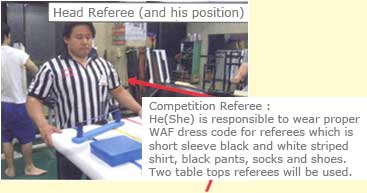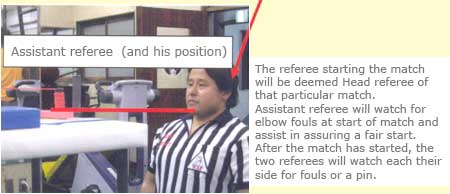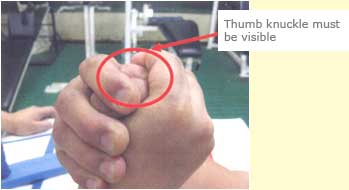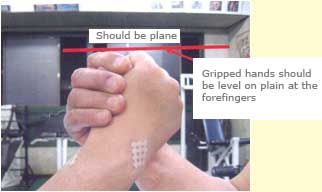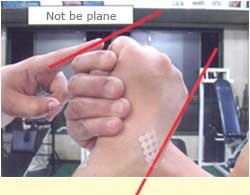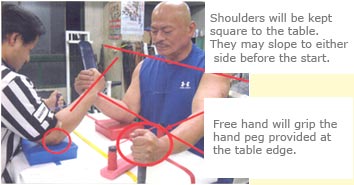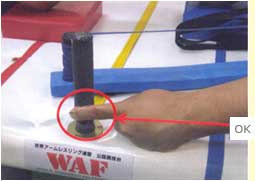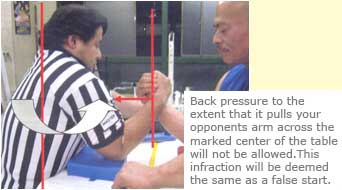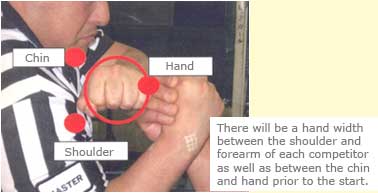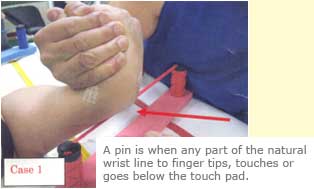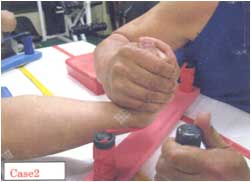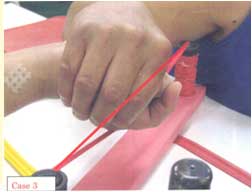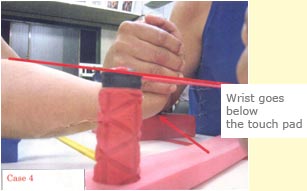Arm Wrestling
History
The matches began In Gilardi's saloon In Petaluma, CA. in 1952. Bill Soberanes, a young journalist was the founder of the organized sport. He was the Inspiration for the annual Petaluma, then Northern California and then the California arm wrestling championship. In 1962 Bill and Dave Devoto got together to form the World's Wrist wrestling Championship, Inc. and take it to one of Petaluma's largest auditoriums. The event was tremendously successful and exciting things began to happen.
In 1968 Charles Schultz did 11 comic strips where snoopy was coming to Petaluma to win the World's Wrist wrestling Championship. Unfortunately In the final strip he was eliminated because the official arm wrestling rules stated you must lock your thumbs with the opposing competitor. Snoopy had no thumb. Drats. These comic strips were done in dozens of different languages and distributed through out the world.
In 1969 Dave Devoto contracted with the American Broadcasting Corporation and the World's Wrist wrestling Championship began a wonderful l6 year relationship with ABC's Wide World of Sports. Arm wrestling came of age.
A story in Playboy magazine substantiated the fact that our televised event was the highest rated show in the young history of Wide World of Sports. Most of the competitors in the sport today first became aware of Arm wrestling through ABC's productions of the Wide World of Sports World's Wrist wrestling Championship. The televised championships ran from 1969 through 1984. We love Wide World of Sports.
Rule & Regulations
|
RULES
TECHNICAL RULES ITEM 1 : TEAMS Must be composed of players of the states represented. If required, a team member or individual may have to produce any document demanded by IAF to establish his/her bonafides to so represent his/her state. The term “team” for all intents and purpose, will mean all of the categories presented both female and male. A team trophy will be awarded, based only on total points accumulated for all categories in both genders. Teams can be broken down to determine points by gender, only to establish ranking of female and male teams from each state. ITEM 2 : NUMBER IN A TEAM Up to two competitors, per category, per state. This includes “Masters, Grand Masters, Disabled and Youth” division. ITEM 3 : WEIGHT CLASSES (A) SENIOR: Men: Up to 55Kg, 60Kg, 65Kg, 70Kg, 75Kg, 80Kg, 85Kg, 90Kg, 100Kg, 110Kg & 110+Kg. Women: Up to 50Kg, 55Kg, 60Kg, 65Kg, 70Kg, 80Kg, & 80+Kg. (B) JUNIOR (Below 18 Years): Boys: up to 50Kg, 55Kg, 60Kg, 65Kg, 70Kg, 80Kg & 80+Kg. Girls: up to 45Kg, 50Kg, 55Kg, 60Kg, 70Kg & 70+Kg. (C) SUB JUNIOR (Below 12 Years): Boys: up to 50Kg, 55Kg, 60 Kg, 65Kg, 70Kg, 80Kg & 80+Kg. Girls: up to 45Kg, 50Kg, 55Kg, 60Kg, 70Kg & 70+Kg. (D) PHYSICALLY CHALLANGED (Men Only): 60 Kg, 75 Kg, 90 Kg & 90+ Kg. (E) MASTERS (Above 40 Years): Men: Up to 70Kg, 80Kg, 90Kg, 100Kg, & 100+Kg. Women: Up to 60Kg, 70Kg, 80Kg, & 80+Kg. (F) GRAND MASTERS (Above 50 Years & Men Only): 75 Kg, 90Kg, & 90+Kg. WEIGHINS (i) There is no clothing allowance; therefore weigh its will be done in the nude if an athlete wishes to qualify for a certain weight class. (Weight has to register to zero, i.e.: if 70kg class it will have to zero to 70.0kg). Without prejudice or bias, if an athlete has artificial limbs or limb, they must weigh in with them on if they wish to compete with them on. (ii) There will be no dispute regarding procedure during weigh-ins. Weigh-ins will follow registration roster by numerical order, i.e.: first team to register with IAF General Secretary, will be the first team weighed and so on. The IAF will have the right to disallow entry to any state not meeting IAF requirements or which creates disorder. (iii) All weigh-ins to be done on IAF approved scales. Weigh-in will be done no sooner that 24 to 30 hours before the first day of competition start time. (iv) During weigh-in, an athlete may be accompanied by a team official of their own state. (v) More than one official weigh-in scale may be used. (vi) The Director of Weigh-ins is the final authority on all weigh-in procedures. (vii) A competitor may weigh-in to their normal weight or jump one weight class higher. ITEM 4 : AGE GROUPS (Same or both Men and Women) Sub Junior : 12 years and Below Junior : 18 years and Below Senior : Any age Masters : 40 years & Above Grand Masters : 50 years & Above Physically Challanged : Any age NOTE :- If so required by IAF, proof of age will have to be given by producing a bona fide passport or medical certificate. If so required by IAF, proof of gender may be required under qualified medical supervision by IAF appointed physicians. ITEM 5 : TEAM POINTS
ITEM 5: EQUIPMENT SPECIFICATIONS (TABLE):
1 Year to 5 Year suspension or as desided by IAF for any future offences. Competition Rules ITEM 1 IAF championships will always be double elimination. All contestants must lose twice. No seeding prior to championships. Contestants are placed on draw sheet by luck of the draw. Team members from the same state will never be matched unless it becomes inevitable. ITEM 2 Contestants for each weight class will be announced and they will come to the stage to be verified against the draw sheet. ITEM 3 Contestants’ names will be called and they have 60 seconds to come to the table. Failure to appear in 60 seconds, they will be given a loss. They will approach the table, shake hands with their opponent, and then take a grip. ITEM 4 The grip is palm to palm, grip at thumb, thumb knuckle must be visible. Gripped hands should be level on a plain at the forefingers. Free hand will grip the hand peg provided at the table edge. This arm may or may not touch the table top. Finger nails should be trimmed so as not to injure your opponent. Stickum/rosin/chalk is permitted. ITEM 5 Back pressure to the extent that it pulls your opponents arm across the marked center of the table will not be allowed. This infraction will be deemed the same as a false start. ITEM 6 Anyone with long hair will have to have their hair restrained in some fashion. Head bands are permitted but not hats. ITEM 7 Shoulders will be kept square to the table. They may slope to either side before the start. ITEM 8 There will be a hand width between the shoulder and forearm of each competitor as well as between the chin and hand prior to the start. ITEM 9 Referees are not there to use force or wrestle with you. A referee will lightly touch competitor’s hands to see that they are properly aligned, wrists straight and arms centered to the table top. ITEM 10 The signal given by the Head Referee is “Ready...Go!” in an unspecified cadence. At the end of the match the referee will say “Stop” and indicate the winner by raising his arm towards him/her. All effort must be made by the referee that the competitors are aware the match is stopped. ITEM 11 A pin is when any part of the natural wrist line to finger tips, touches or goes below the touch pad. ITEM 12 Competitor’s legs can be wrapped around the table leg or braced against an opposite table leg prior to the start of the match, providing they are not interfering with their opponent. Feet can be off the ground during competition and legs can be moved in any fashion as long as they don’t interfere with their opponent. ITEM 13 In the event of an injury during competition, the competitor’s name will continue to be brought forward until he/she has fulfilled the two loss commitment. The match that a competitor was injured in will be regarded as a loss. ITEM 14 There is no time limit during an actual bout. However, if in the estimation of the Head Referee or a IAF authorized physician, that a competitor is deemed unfit to continue, the match will be stopped. ITEM 15 No breaks in contest during or between matches, unless there is equipment failure, draw sheet mistake or authorised by officials. ITEM 16 No competitor will be matched twice against the same opponent unless for place standing. ITEM 17 The referee’s may give a disabled puller some allowances for his handicap. ITEM 18 You can only pin your opponent on the winning side of the table. ITEM 19 If competitors fail to come to the table in the 60 seconds allotted they will be given a loss. Their name will be dropped to its proper slot, the same as a loss in an actual bout. If they already have a loss they would drop out of the tournament for that particular weight class. ITEM 20 Competitors have one minute to “Grip Up”. If in that time, they have not gripped up, they will be given a “referee’s grip”. A referees’ grip consists of the following procedure; Competitors’ hands are placed palm to palm by the referee, the thumbs are pushed down by the referee, the fingers are wrapped by the referee, first one competitor, then the other. As they are wrapped referee asks competitor if he/she wants their thumb covered or not. Thumb knuckles will be showing, forefingers level, wrists straight and arms centered. Competitors are not to move from this set up. Examples of movement are fingers re-gripping, back pressure, bending wrists, early start or elbow lifting off the pad. Any movement by any competitor will result in a foul being given against the one that moves. ITEM 21 A foul will be given when a competitor’s elbow loses contact with the elbow pad. A competitor is considered to lose contact with the pad when: (A) The elbow lifts vertically off the pad, no matter how insignificant, as long as there is clearance between the pad and the elbow. It is not considered an elbow foul if the elbow has lifted off the pad, but the competitor still has contact with the elbow pad with their triceps or their forearm. (B) An elbow foul will be called if the competitor is riding on their triceps or forearms and the elbow extends beyond any side of the elbow pad. (C) Any foul that occurs simultaneously with a foul by your opponent will be considered Coincidental, the match will be stopped and restarted and no fouls will be given. ITEM 22 The referee will call one foul for “causing a slip out” when: (A) You lift your fingers off your opponent’s hand prior to a slippage (B) You close your fingers as to make a fist inside your opponent’s hand (C) You’re in break wrist position and you pull your fingers inside your opponents hand, therefore you are unable to hold your grip. (D) Straps will be used when any match ends by way of a slip-out not resulting in a foul. A slip-out occurs when both competitors have lost complete contact with one another. The official must be certain of the circumstances preceding the actual slip out before calling a foul. If the official is uncertain as to who caused the slippage or it was caused by the actions of both competitors, then straps will be used and no foul will be given. (E) When straps are employed, the officials will ask competitors to place their elbows to the back of their respective elbow pads, place their hand palm to palm, fingers extended and thumbs up. Opposite hand will grip hand peg. In this position the strap can be quickly installed. Only the official can adjust the strap. Competitors may ask to loosen it or move it if it’s uncomfortable. The strap cannot be lower than 1" below the natural wrist line. (F) After the strap is installed, competitors may take their grip and place their elbow to their choice of position. (G) If a competitor intentionally slips out during the match in a losing position (losing position is determined by being more than 2/3 rd of the way down to the pin pad), the competitor will lose that particular match. Any intentional slip is an automatic FOUL. ITEM 23 : WARNINGS (A) Any early movement with shoulders, arm, hand or fingers will be a warning unless competitors are in a referee’s grip. Then it would be a foul. (B) If one competitor is causing a delay “locking up” the referee will give the offender a warning. (C) Letting go of the peg will result in a warning being called to the offender, without stopping the match. If an advantage is gained prior to re-gripping the peg, the match will be stopped and the offender will be given a foul. Contact with the peg must be above the table. One armed or one hand persons do not have to grip the peg. ITEM 24 : FOUL (A) Competitor’s shoulder must not cross the “centerline” between pegs during competition. This will be a FOUL. (B) Competitor cannot use any other part of the body to pin their opponent such as chin, shoulder or head. A FOUL will be given. (C) Intentionally pushing of your own hand into an opponents shoulder will result in you getting a FOUL. (D) When a competitor starts to put themselves in a “break arm” or “dangerous position”, the referee will caution the competitor loudly so that the competitor understands the caution. Referee will instruct the competitor to face their competitive arm, so as to keep the hand, arm and shoulder in a straight line. Competitors must never force their shoulder inwards, ahead of their arm or hand, towards the table. (E) Competitor’s cannot drop the competing shoulder below the level of the elbow pad when in an neutral or losing position. This will be considered a dangerous position. (F) Any obviously intentional action that causes your opponent to get a foul will result in no foul for the opponent and you receiving the foul instead. Example obviously intentionally pushing your opponent off the back of the elbow pad. ITEM 25 Foul language, poor sportsmanship or abuse towards an official will result in a FOUL. If it continues, Competitor or official will be barred from the tournament. ITEM 26 30 second rest is permitted after a FOUL. Note: Two warnings will equal one foul. Two fouls, competitor will lose that particular match. Each competitor should know the following words. UNIVERSAL WORDS Ready go, Knuckles, Elbows down, Wrist, Shoulders, Stop, Warning, Winner, Dangerous position, Referees Grip, Back, Thumb Down, Don’t move, Center, Dangerous position, Grip, Strap, Foul, Over, Under, Competition Fouls. |
Affiliations
Affiliated with Indian Arms Wrestling Federation

Success Player



